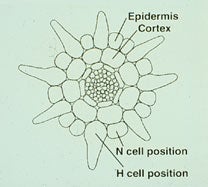This page provides some background information about our research. It’s meant to help you begin to understand our experimental system and why we find it so attractive. If you want to skip this part and find out what we have discovered or what we are currently doing in the lab, visit the Prior Research Results or Current Research Projects sections.
A fundamental feature of development in multicellular organisms is the specification and patterning of distinct cell types. Our lab focuses on development of hair and non-hair cell types in the root epidermis of Arabidopsis thaliana as an elegant and powerful model system for uncovering the mechanisms of cell specification.
Why is root epidermis development in Arabidopsis such a wonderful experimental system? Here are some reasons:
The root epidermis is composed of only two cell types.
Although most tissues contain many different cell types, the root epidermis consists of only two: hair cells and non-hair cells. A hair cell differs from the non-hair cell in the long extension it forms (the root hair), which is important in water and nutrient uptake.The presence of only two cell types in the root epidermis means that each newly-formed cell makes a simple “either-or” choice: it must decide whether to develop into a hair cell or a non-hair cell.

left: Drawing of epidermal cell files in an Arabidopsis root tip. right: Photograph of an Arabidopsis root tip, showing the progressive development of hair cells along its length.
The development of root epidermal cells is easy to observe.
The epidermal cells are on the outer surface of the root, making them easy to see and study. Also, they are continuously produced as the root grows, due to cell divisions in the meristematic region at the root tip. As they age, the cells become progressively more differentiated. Notably, root epidermal cells are organized into columns (or files) along the length of the root, with the youngest (recently-formed) cells nearest the bottom of a file and the oldest (most differentiated) cells near the top of a file. Thus, it is easy to study any particular stage of epidermis development, from beginning to end, by simply examining cells at a specific location along the length of the files. Furthermore, we can distinguish the developing hair cells from developing non-hair cells by several criteria, including differences in cell length, cytoplasmic density, vacuolation, and marker gene expression.
A simple position-dependent pattern of hair and non-hair cell types is generated in the Arabidopsis root.
Like other members of the plant family Brassicaceae, Arabidopsis produces its hair and non-hair cells in a particular pattern. The hair cells lie outside the intercellular space between two underlying cortical cells (designated the “H” cell position of the epidermis) and non-hair cells develop over a single cortical cell (designated the “N” cell position). (Note the drawing to the left.) This simple correlation between cell position and cell differentiation implies that cell-cell communication is important in the establishment of this cell-type pattern.
The Arabidopsis root has a simple structure.
There are an unusually small number of tissue and cell types in the Arabidopsis root (see the photo on the right). It possesses a single layer of cells within its epidermal, cortical, endodermal, and pericycle tissues, as well as a simple set of cells in its vascular tissue. In addition, the number of cells within each layer is fairly constant. For example, the Arabidopsis primary root always possesses eight files of cortex cells, eight files of root-hair cells, and approximately 10-14 files of non-hair cells in the epidermis. Furthermore, the developmental origin of each of the tissue types within the root meristem has been defined.
Root epidermis development can be efficiently analyzed in seedlings.
Epidermal cells develop on the primary root immediately after germination of the Arabidopsis seed. Therefore, it is possible to analyze root epidermis development at an early stage in plant life (after only 3 or 4 days of incubation) when plants are small (about 1 cm long). These features enable large numbers of individuals to be grown on defined media and studied with ease. For example, we typically examine 200-400 individuals on a single 10 x 10 cm Petri dish (see photograph).

Photograph of five day old Arabidopsis seedlings on nutrient agar in a Petri plate. The plate was incubated in a vertical orientation, causing the roots to grow on the agar surface.
Root hair cells and non-hair cells are dispensable.
We have isolated mutants that entirely lack hair cells, as well as mutants that entirely lack non-hair cells, and these mutants are perfectly healthy and fertile. Thus, hair cells and non-hair cells are not essential to the Arabidopsis plant, which means that we can genetically manipulate the production of hair and non-hair cells in any way we wish without altering plant viability.
Arabidopsis thaliana is an excellent organism for molecular genetic studies.
Although it has no horticultural value, Arabidopsis has many features that make it the most popular model organism for plant biology studies. It grows rapidly (life cycle of 6-8 weeks), is naturally self-fertile (and can be cross-pollinated easily by hand), produces a large number of offspring (typically >1000 seeds per plant), is readily mutagenized, and has a small genome (120 Mb) that has been completely sequenced. These attributes are extremely helpful for the kind of molecular genetic studies we do in our lab. For more detailed information about the virtues of Arabidopsis as a model organism, visit the The Arabidopsis Information Resource (TAIR) website.
For more information about our research please go to the Prior Research Results or Current Research Projects sections.




